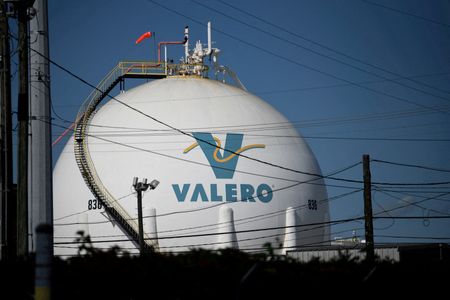By Erwin Seba
HOUSTON (Reuters) – U.S. oil refiners are dialing back operating runs this quarter after sky-high utilization rates last year, and aim to operate at between 85% and 89% of capacity, according to company outlooks and analysts’ estimates.
Lower rates will cut supplies of gasoline, diesel and jet fuel, helping keep profit margins high during one of the weakest demand periods of the year. The run-cuts reflect an effort to catch up on maintenance. Planned overhauls this quarter will be the highest in five years, analysts said.
The largest U.S. refiner by capacity, Marathon Petroleum Corp, said it plans to operate at 88% in the first three months, down from 94% last quarter. Second-largest Valero Energy Corp is targeting between 85% and 88%, down from 97% last quarter.
“We have been expecting a pretty hefty spring turnaround season in 2023 after refiners ran hard in 2022,” said Matthew Blair, refining analyst at research firm Tudor, Pickering, Holt & Co.
Maintenance work will be heaviest at refineries along the U.S. Gulf Coast, analysts said, with major overhauls in coming weeks at plants operated by Marathon, Valero, Exxon Mobil Corp and Phillips 66.
“We are heavy centric first quarter on our turnaround” spending, Phillips 66 Chief Executive Mark Lashier said on Tuesday. It plans to run in the mid-80% of capacity, down from 91% last quarter.
Profits from refining a barrel of oil into fuels this quarter are projected to average $21 per barrel, excluding renewable fuel credits, in the largest processing region, analysts forecast, down from about $27 per barrel last quarter.
Refiners had scaled back maintenance in 2020 and 2021 to reduce the risk of contractors bringing in the COVID-19 virus, said John Auers, managing director of Refined Fuel Analytics.
Then, in 2022, “they had really high margins so they pushed production as hard as they could,” Auers said.
In addition to refinery turnarounds, the shutdown of BP Plc’s joint-venture Toledo, Ohio, and Suncor’s Commerce City, Colorado, refineries are limiting supply, said Andrew Lipow, president of Lipow Oil Associates.
“I think you’re looking into April before production returns” to prior levels, Lipow said.
National refining capacity will get a boost late in the first quarter when a new crude distillation unit comes online at Exxon’s massive Beaumont, Texas, refinery. But it will be offset late in the year when Lyondell Basell shuts its Houston refinery.
Auers estimates U.S. refining capacity will remain at about current levels for the remainder of the decade, and drop in the 2030s. Overall capacity fell to 17.9 million bpd last year, from nearly 19 million bpd in 2019.
(Reporting by Erwin Seba in Houston; Editing by Matthew Lewis)

